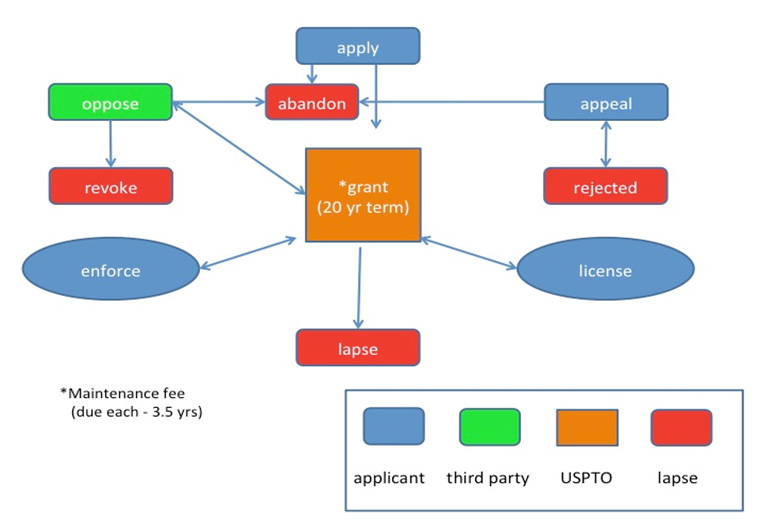
This 4 part blog series over the next few weeks will build a framework for understanding, maximizing, and monetizing your intellectual property portfolio in the US and international markets.
This blog on Life Cycle of a Patent demystifies the complexities associated with obtaining a patent in the US. In our next blog, we will try to present various options for optimizing patent protection internationally. Then we will present overviews of other types of IP (such as trademarks and trade secrets), and finally we want to reward you with a set of best practices to bear in mind in protecting each of these IP in your portfolio.
Understanding your IP portfolio is important
As markets converge into a global network of production, distribution, and sales enabled by internet-facilitated logistics and e-commerce, durability of patented innovations (both in US and internationally) forms a substantial part of the value of your IP portfolio. This is true at all stages of your company’s life – from startup to a global enterprise.
Life of a Patent – What You Must Know
The U.S. Patents
A patent issued by a government authority, such as the U.S. Patent and Trademark Office (“USPTO”) grants its owners the sole right to sell, import, contribute to (including right to exclude others from using the invention or import the invention to the US) the claimed invention in the U.S. In the U.S., USPTO grants three (3) types of patents – utility, plant, and design patents. The USPTO also grants provisional patents to inventors who are not yet ready to file the final applications.
Utility Patent
A utility patent protects a claimed useful, new, and non-obvious innovation for 20 years from its filing date (subject to payment of maintenance fees to extend the life of the patent in 3.5 year increments following its original issue date). Note, you will incur maintenance fees 7 times at each 3.5 years of its life.
Design and Plant Patents
Unlike utility patents, design and plant patent life cycles extend without the payment of maintenance fees for 14 years (design patents) and 20 years (plant patent). The subject matter of a design patent protects ornamental innovations, such as, the look of a configuration or shape of an article, or the texture or surface ornamentation applied to an article. Plant patent covers a distinct and new variety of plants.
Cutting Short of Life Cycle
As shown in the “Patent Life Cycle” chart below, a patent’s life can sometimes be cut short. It may die before, during, or after issuance. A patent may die prematurely even before issuance due to lapse or failure to file the final application. If during examination or in an opposition proceeding (initiated by third parties with such rights), a patent applicant is unable to persuade the USPTO officials of the patentability of an innovation, the patent can die during the issuance process. The life of a utility patent may also be cut short for failure to pay the required maintenance fees (as much as 7 times during its life cycle) post issuance, during its life.
The Provisional Patents
A provisional patent confers a very limited right – to an invention (a priority date or pretend filing date) for only the described subject matter in the application. A provisional patent application requires no claims or formal papers other than a provisional cover sheet. However, best provisional patents include claims. Provisional patents are, as a matter of practice, not examined. They merely reserve an invention priority date for up to 12 months, and they do not trigger examinations until they are converted to formal non-provisional applications. If a non-provisional application is not filed during that time (unless an extension is sought), the provisional priority date lapses and your rights are lost.
A valid provisional application must have 4 essentials. There must be (i) at least one common inventor in the provisional and the regular application (ii) common inventive disclosures in the two (iii) overlap in time or codependency between the two; and (iv) must amend the regular application with referencing the provisional.
Public Disclosures
In contrast to most other countries that require “absolute novelty” with no public disclosure, under U.S. law, an invention owner has a one-year grace period in which to file a patent application, following a public disclosure or commercialization of an invention. In most foreign countries, publication of the invention before the date of the application results in forfeiture of patent rights, as no grace period is afforded. Of course, it is still important to file for patent application in the U.S. as soon as possible with or without public disclosure, even when international patent protection is not desired. This is especially in view of the America Invents Act’s (AIA) adoption of the first to file system in the U.S. on March 16, 2013. AIA is the most significant patent reform law in the US since 1950’s. Under AIA, U.S. transitions from a first to Invent patent priority system to a first to file system.
What is a patent claim?
Patent claims are the most important component of a patent. They define the limits of exactly what the patent does, and does not cover. In addition, claims define the boundaries of a patent holder’s rights – and they outline what the patent holder may exclude others from doing. This is why drafting (or at least review) of claims by an expert is so important.
Invalidity Claims
Once issued, a patent number is assigned to the invention for marking goods and services (articles) incorporating the relevant innovation, and the patent is enforceable against any would be infringers. An issued patent is presumed valid, but still subject to invalidity claims, any time, by third parties. Yes, this can happen even if your company is just a few days away from trading on Wall Street – as in the case of invalidity claims against Trulia patents – brought by Zillow who also faced invalidity claims against its patents on automatic valuation of houses. An invalidity claim may be filed in court or as a re-examination proceeding at the USPTO. Most often, patent invalidity claims are raised as a defense by an accused infringer.
Foreign Filing License
U.S. law requires an owner of an invention born in the U.S. acquire a foreign filing license from the USPTO prior to applying for a patent overseas. As a result, each patent application filing triggers a request for a foreign filing license, which must be acquired either before an application is filed in U.S. or before the expiration of six months from filing the U.S. application. The foreign filing license requirement automatically expires six months after the U.S. filing date, unless the filing receipt mandates that the invention be kept secret, in which event the patent owner must first acquire USPTO permission to file overseas.
What are the average times patent attorneys take to prepare and file?
Regular – 8 weeks
Provisional – 4 weeks
Options on Timelines
The USPTO has established ways to expedite (fast track) a patent application. Just as in most things in life, if you want something faster, you have to pay a price. For fast track certain filing and examination requirements must be met. You can download a graph with further details at USPTO site:
| Tracks | Requirements |
| Track One; Fast Track
$4000 fee; limits on # of claims |
First Action < 5 months; final decision < 12 months
|
| Accelerated
$140 fee; limits on # of claims |
First Action < 5 months; final decision < 12 months
|
| Prosecution Highway
No fees; no limit on # of claims |
Acceleration following favorable results from a foreign patent office
|
You are allowed to Speeding up or Slow Down within the 3 fast track lanes above. The default non-fast track process averages about 3 years.
Cost of obtaining Patents
Cost of a patent includes attorney and draftsman fees + USPTO filing fees. Attorneys costs are of two folds: application preparation + prosecution (after office action). Below chart gives you some average legal fee estimates. Note these are only estimates and averages; actual cost may vary slightly.
| Type | Legal fees (Application) | Prosecution Fees |
| Simple to moderately complex | $4,000 – $12,000 | $3,500 |
| Complex | $12,500 – $16,000 | $4, 000 |
| Software patents | $16,000 upwards | $4,500 upwards |
Why a Patent Strategy?
Invention or innovation is not a singular event. Succeeding in the marketplace you intend to play involves understanding your competitive advantage and maintaining a commercially viable portfolio of IP rather than merely getting a single patent or copyright. For this, you need to have an overall strategy and useful tools to protect and monetize your inventions. This involves keeping a keen eye on your IP portfolio and looking for opportunities to expand your product line and IP portfolio while minimizing cost – whether it is by licensing, sale/spin-off, alliance, joint venture, donation or even abandoning.
A case for global patent procurement
The complexities and costs in securing patents globally have in the past few decades fueled growth of international patent conventions. Where, when and how to file for patents to optimize their force and effect in a diverse yet rapidly integrating global network of markets and patent offices entails navigating complex international treaties, as well as processes applicable to regional patent offices and courts. These markets, agencies, and courts operate under divergent laws, practices, and enforcement mechanisms. Navigating these broadly dispersed and unpredictable patent authority standards often entail weighing overseas patent options based on a country’s legal system, procedures, culture and common practices.
What treaties do?
Despite the challenges of such elusive factors in securing patents globally, widely adopted treaties grant a certain level of certainty at least in signatory countries. Treaties will help gain some level of certainty on key factors, when devising a patent strategy or monetizing an innovation with international commercial potential.
The Life Cycle of a Patent (US)
What’s next?
Our next blog will build a framework for maximizing international patent rights overseas.
By Lynette Wylie and Shanika Weerasundara.

